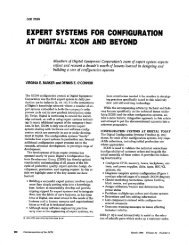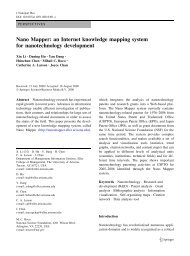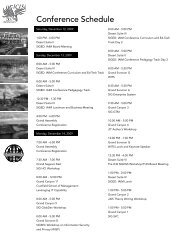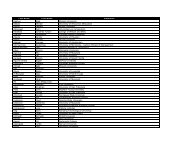business intelligence and analytics: from big data to big impact
business intelligence and analytics: from big data to big impact
business intelligence and analytics: from big data to big impact
You also want an ePaper? Increase the reach of your titles
YUMPU automatically turns print PDFs into web optimized ePapers that Google loves.
Chen et al./Introduction: Business Intelligence ResearchOver its eight years of operation, it has obtained deep, multicolorimages covering more than a quarter of the sky <strong>and</strong>created three-dimensional maps containing more than 930,000galaxies <strong>and</strong> over 120,000 quasars. Continuing <strong>to</strong> gather <strong>data</strong>at a rate of 200 gigabytes per night, SDSS has amassed morethan 140 terabytes of <strong>data</strong>. The international Large HadronCollider (LHC) effort for high-energy physics is anotherexample of <strong>big</strong> <strong>data</strong>, producing about 13 petabytes of <strong>data</strong> ina year (Brumfiel 2011).Smart Health <strong>and</strong> WellbeingMuch like the <strong>big</strong> <strong>data</strong> opportunities facing the e-commerce<strong>and</strong> S&T communities, the health community is facing atsunami of health- <strong>and</strong> healthcare-related content generated<strong>from</strong> numerous patient care points of contact, sophisticatedmedical instruments, <strong>and</strong> web-based health communities.Two main sources of health <strong>big</strong> <strong>data</strong> are genomics-driven <strong>big</strong><strong>data</strong> (genotyping, gene expression, sequencing <strong>data</strong>) <strong>and</strong>payer–provider <strong>big</strong> <strong>data</strong> (electronic health records, insurancerecords, pharmacy prescription, patient feedback <strong>and</strong>responses) (Miller 2012a). The expected raw sequencing <strong>data</strong><strong>from</strong> each person is approximately four terabytes. From thepayer–provider side, a <strong>data</strong> matrix might have hundreds ofthous<strong>and</strong>s of patients with many records <strong>and</strong> parameters(demographics, medications, outcomes) collected over a longperiod of time. Extracting knowledge <strong>from</strong> health <strong>big</strong> <strong>data</strong>poses significant research <strong>and</strong> practical challenges, especiallyconsidering the HIPAA (Health Insurance Portability <strong>and</strong>Accountability Act) <strong>and</strong> IRB (Institutional Review Board)requirements for building a privacy-preserving <strong>and</strong> trustworthyhealth infrastructure <strong>and</strong> conducting ethical healthrelatedresearch (Gelf<strong>and</strong> 2011/2012). Health <strong>big</strong> <strong>data</strong> <strong>analytics</strong>,in general, lags behind e-commerce BI&A applicationsbecause it has rarely taken advantage of scalable analyticalmethods or computational platforms (Miller 2012a).Over the past decade, electronic health records (EHR) havebeen widely adopted in hospitals <strong>and</strong> clinics worldwide.Significant clinical knowledge <strong>and</strong> a deeper underst<strong>and</strong>ing ofpatient disease patterns can be gle<strong>and</strong>ed <strong>from</strong> such collections(Hanauer et al. 2009; Hanauer et al. 2011; Lin et al. 2011).Hanauer et al. (2011), for example, used large-scale, longitudinalEHR <strong>to</strong> research associations in medical diagnoses<strong>and</strong> consider temporal relations between events <strong>to</strong> betterelucidate patterns of disease progression. Lin et al. (2011)used symp<strong>to</strong>m–disease–treatment (SDT) association rulemining on a comprehensive EHR of approximately 2.1million records <strong>from</strong> a major hospital. Based on selectedInternational Classification of Diseases (ICD-9) codes, theywere able <strong>to</strong> identify clinically relevant <strong>and</strong> accurate SDTassociations <strong>from</strong> patient records in seven distinct diseases,ranging <strong>from</strong> cancers <strong>to</strong> chronic <strong>and</strong> infectious diseases.In addition <strong>to</strong> EHR, health social media sites such as DailyStrength <strong>and</strong> PatientsLikeMe provide unique research opportunitiesin healthcare decision support <strong>and</strong> patient empowerment(Miller 2012b), especially for chronic diseases such asdiabetes, Parkinson’s, Alzheimer’s, <strong>and</strong> cancer. Associationrule mining <strong>and</strong> clustering, health social media moni<strong>to</strong>ring<strong>and</strong> analysis, health text <strong>analytics</strong>, health on<strong>to</strong>logies, patientnetwork analysis, <strong>and</strong> adverse drug side-effect analysis arepromising areas of research in health-related BI&A. Due <strong>to</strong>the importance of HIPAA regulations, privacy-preservinghealth <strong>data</strong> mining is also gaining attention (Gelf<strong>and</strong> 2011/2012).Partially funded by the National Institutes of Health (NIH),the NSF BIGDATA program solicitation includes commoninterests in <strong>big</strong> <strong>data</strong> across NSF <strong>and</strong> NIH. Clinical decisionmaking, patient-centered therapy, <strong>and</strong> knowledge bases forhealth, disease, genome, <strong>and</strong> environment are some of theareas in which BI&A techniques can contribute (Chen 2011b;Wactlar et al. 2011). Another recent, major NSF initiativerelated <strong>to</strong> health <strong>big</strong> <strong>data</strong> <strong>analytics</strong> is the NSF Smart Health<strong>and</strong> Wellbeing (SHB) 6 program, which seeks <strong>to</strong> addressfundamental technical <strong>and</strong> scientific issues that would supporta much-needed transformation of healthcare <strong>from</strong> reactive <strong>and</strong>hospital-centered <strong>to</strong> preventive, proactive, evidence-based,person-centered, <strong>and</strong> focused on wellbeing rather than diseasecontrol. The SHB research <strong>to</strong>pics include sensor technology,networking, information <strong>and</strong> machine learning technology,modeling cognitive processes, system <strong>and</strong> process modeling,<strong>and</strong> social <strong>and</strong> economic issues (Wactlar et al. 2011), most ofwhich are relevant <strong>to</strong> healthcare BI&A.Security <strong>and</strong> Public SafetySince the tragic events of September 11, 2001, securityresearch has gained much attention, especially given theincreasing dependency of <strong>business</strong> <strong>and</strong> our global society ondigital enablement. Researchers in computational science,information systems, social sciences, engineering, medicine,<strong>and</strong> many other fields have been called upon <strong>to</strong> help enhanceour ability <strong>to</strong> fight violence, terrorism, cyber crimes, <strong>and</strong> othercyber security concerns. Critical mission areas have beenidentified where information technology can contribute, assuggested in the U.S. Office of Homel<strong>and</strong> Security’s report“National Strategy for Homel<strong>and</strong> Security,” released in 2002,including <strong>intelligence</strong> <strong>and</strong> warning, border <strong>and</strong> transportation6 “Smart Health <strong>and</strong> Wellbeing (SBH),” Program Solicitation NSF 12-512(http://www.nsf.gov/pubs/2012/nsf12512/nsf12512.htm; accessed August 2,2012).MIS Quarterly Vol. 36 No. 4/December 2012 7










